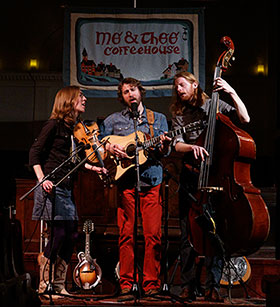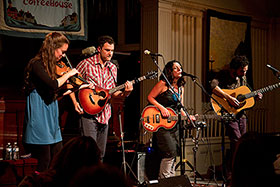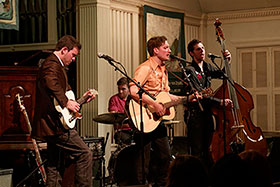Thirty Years On
Anne walks into the kitchen with two pans of brownies she made that afternoon. She’s met by Jeb, Kacy, Ellen and David, who are arranging the Italian soda mix-ins and the espresso machine. The pastries are being cut and lined up like little tin soldiers ready to march off.
Wayne, Mike and Gordie are unfolding the legs to the portable stage that will be set up in front of the pulpit. Jim is laying down cables and testing the microphones as John lugs the Oriental rug on stage. Bo unfolds chairs and arranges them in straight lines.
In the Nichols Room, a performer who arrived at Logan Airport just three hours ago on a crowded jet from the West Coast is changing his guitar strings and enjoying a dinner delivered a half-hour earlier. Down on Pond Street, John and Maria are preparing their guestroom where he’ll spend the night after the concert. The room is fondly referred to as “the Me&Thee motel.”
Out front, Lisa and Adriana are setting up the cash drawer and the ticket envelopes and Rita sets out the CDs and songbooks that will be sold tonight. Chris artfully hangs the new anniversary tee shirts and pyramids the earth-toned mugs that he hopes to sell tonight. He’s prepared to hawk them during intermission like an old fishmonger.
After the equalization is set and the feedback is controlled, the rest of the soundcheck proceeds without a hitch. The coffee aroma starts to waft into the parish hall. The performer warms up with some hot slides of the guitar. The tallest volunteer, Rob, stretches to reach the tiny nail to hang the colorful banner behind the stage. And the line is starting to form down Mugford Street. All is now set for another evening performance at one of the oldest volunteer coffeehouses in America. This is the 1000th performance. It’s little noted but everyone quietly understands its significance.
It’s another night at the Me&Thee coffeehouse at the Unitarian Universalist Church of Marblehead. Thirty years on, this coffeehouse is decidedly different from the smoky, dark, Bohemian stereotype of the 1960s. Today’s Me&Thee is run by a small army of volunteers from all over the North Shore and continues to attract audiences from all over New England.
They are teenagers and seniors, Gen-Xers and graying business people, professional types and hip young couples in leather. Somehow they arrive at this small place at the end of Route 114 to enjoy the music, ambiance, and atmosphere that one city writer described “as warm and friendly as your friend’s living room.”
Dubbed “the Carnegie Hall of church coffeehouses” by the Boston Globe, the Me&Thee has presented over a thousand concerts with a who’s who of talent including Tracy Chapman, Pete Seeger, Dar Williams, Ellis Paul, Shawn Colvin, Tom Rush, Bill Staines, and local favorite Jeanie Stahl. Over the decades, the shows have featured mimes, storytellers, Delta blues guitarists, harpists, pianists, Dixieland jazz bands, and even a folksinger who juggled in the dark.
But how has this non-profit organization survived three decades of musical change as disco music invaded the country in the 70s, MTV changed musical tastes in the 80s, and the Internet’s MP3s transformed music in the 90s?
Organizers say that the Me&Thee has succeeded by attracting the best talent from all over the country who have built their careers playing in smaller rooms where spontaneity and a listener-performer dialogue develops. From the beginning, the Me&Thee earned its reputation as a “listening room.” The alcohol-free and smoke-free environment encouraged a friendly and relaxed atmosphere. Dozens of volunteers formed the core of a “folk community” that endured the changing times.
But as the guy who founded the Me&Thee back in 1970, I still find the real answer elusive.
I never planned this.
On that cold February night thirty years ago when the Unitarian Church sponsored a “night of folk music” and charged 50 cents to get in, it was showing faith in a young man with an idea. It showed great support for an unproven program that was fraught with dangers. What if the “wrong element” showed up? What would happen if kids trashed the pristine Parish Hall? And worse, what if nobody came? Well, the chaperones were there. But so were the audience members.
We took in $61.33 that first night and paid the performers — Bob Simons of Peabody and Jim King of Marblehead — $15.00 apiece. But the chaperones soon joined the crew and the name “me and thee coffeehouse” was born.
Through the years, volunteers have carried out every facet of this increasingly complicated operation and appreciative audiences have kept walking through the door. But what do they find so appealing?
In 1975, Mike Barnicle wrote in his column in the Boston Globe:
It’s a fact that small rooms are unable to survive in the wake of concert tours and performers geared for one-night stands and a lot of cash up front. There are hardly any good rooms left. But there are smaller, less known places like the Me&Thee up in Marblehead.
That was like the imprimatur.
We were accepted by the establishment as a real place, a destination, and a worthy effort. For years, we rallied around the music and slowly built a stronger volunteer community. But there have been times that tested our fortitude. Like the year when snowstorms hit five Fridays in a row and almost blasted us out of existence. (We now close for the month of January and cancel performances if snow is forecast.) The time that Josh White Jr. got lost on his way to Marblehead from New York and we had to refund everybody’s entrance fee, including Dr. Timothy Johnson of ABC, who tried the coffeehouse just once, that night. The evening when a performer almost walked out because we provided Poland Springs and she wanted Perrier. (We told her that Penni’s was still open and she had time to get it herself!)
Or the first night when the late downeast storyteller Marshall Dodge showed up at 8:20 for an 8:30 show and proclaimed that “he loved to see promoters sweat.” (He later grew into a wonderful friend and convinced us that we should charge more because “people won’t respect you if you charge too little.”)
But most of the memories of the Me&Thee are so enrichingly positive. A family dinner with Pete Seeger with our then 9-year-old son enthralled by his stories. A teary-eyed Greg Brown acknowledging a respectful standing ovation as he walked out on stage for his first concert after his grandmother’s death. A hug and tears shared by Tracy Chapman following a thunderous response to her first on-stage performance. These are the emotional events that bring people together and keep them coming back. As M.C. Richards wrote, “one of the truths of our time is this hunger deep in people for coming into relationship with each other.”
The Me&Thee continues to build that relationship through meaningful music, a growing community and a little bit of luck.


